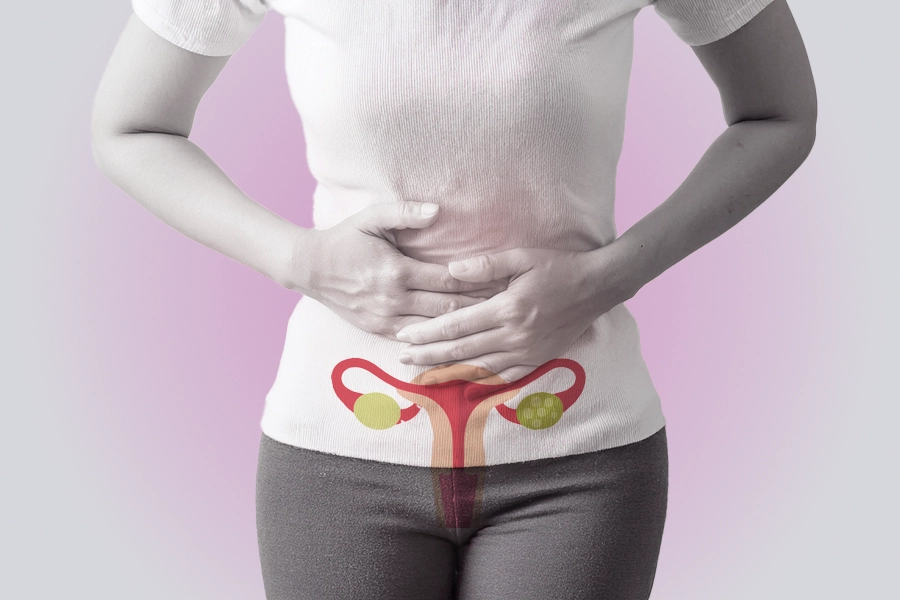Polycystic Ovary Syndrome (PCOS) is a prevalent hormonal disorder that affects an estimated 6–13% of women of reproductive age, according to the World Health Organization (WHO). Despite its widespread occurrence, up to 70% of women with PCOS remain undiagnosed, highlighting the urgent need for increased awareness and early detection.
PCOS is a leading cause of ovulatory dysfunction and infertility, significantly impacting a woman’s reproductive health. Beyond reproductive issues, PCOS is associated with a range of metabolic comorbidities including insulin resistance, type 2 diabetes and cardiovascular disease, which further compromise overall health.
Given the complexity of PCOS and the wide spectrum of ways it can affect individuals, understanding its underlying causes, symptoms and potential health risks is crucial.
In this article, we will delve into the key aspects of PCOS, covering its causes, symptoms, risk factors and complications.
Introduction
Polycystic Ovarian Syndrome (PCOS), also known as Hyperandrogenic Anovulation (HA) or Stein-Leventhal Syndrome, is one of the most common and complex endocrine and metabolic disorders that affects women, primarily during their reproductive years.1 It presents with a wide range of symptoms and is often characterized by several key features including anovulation (lack of ovulation), infertility, obesity, insulin resistance and the presence of polycystic ovaries.2
The syndrome was first described by Stein and Leventhal in 1935, when they identified the hallmark features of the disorder which primarily included menstrual disorders, hirsutism (excessive hair growth) and infertility. Their findings were based on a case series of seven women, highlighted a consistent pattern of disrupted ovarian function, which was closely linked to hormonal imbalances. The key hormonal abnormalities observed included excess androgen production (leading to hyperandrogenic symptoms like hirsutism) and anovulation (failure of the ovary to release a mature egg), which contributed to menstrual irregularities and infertility. This initial description laid the foundation for understanding Polycystic Ovarian Syndrome (PCOS) not just as a reproductive disorder but also as an endocrine disorder affecting hormone regulation.3
The Three Primary Features of PCOS
Polycystic Ovary Syndrome (PCOS) can be presented in different ways depending on the individual. The most widely accepted diagnostic framework for PCOS is the Rotterdam Criteria, which includes three primary diagnostic features:4
1. Hyperandrogenism: Elevated levels of male hormones (androgens), which manifest as clinical symptoms such as:
◦ Hirsutism (excessive hair growth in a male-like pattern)
◦ Acne
◦ Scalp hair thinning or androgenic alopecia (hair loss)
2. Ovulatory Dysfunction: This is reflected in menstrual irregularities, including:
◦ Oligomenorrhea (infrequent menstrual periods),
◦ Amenorrhea (absence of menstrual periods),
◦ Anovulation (failure of the ovaries to release an egg).
3. Polycystic Ovarian Morphology (PCOM): Polycystic Ovarian Morphology (PCOM) refers to the presence of multiple small ovarian follicles, typically 12 or more per ovary, each measuring between 2 to 9 millimeters in diameter, as observed on ultrasound. Additionally, PCOM is characterized by an enlarged ovarian volume of more than 10 mL. This condition is often described as having Polycystic Ovaries.5 Despite the term “cystic,” the ovaries do not actually contain true cysts in Polycystic Ovarian Syndrome (PCOS). Instead, the fluid-filled sacs (follicles) in the ovaries surround the eggs and give rise to the characteristic “polycystic” appearance seen in PCOM. These follicles are underdeveloped sacs in which eggs normally mature. However, in PCOS, these sacs often fail to release an egg, preventing ovulation and contributing to irregular menstrual cycles and fertility issues.
This classification allows for a broad spectrum of symptoms, enabling healthcare professionals to provide tailored treatments based on the patient’s unique presentation.
Metabolic Impact of PCOS
Although it was initially recognized as a reproductive disorder, PCOS is now well-established as a metabolic condition. Many women with PCOS exhibit insulin resistance and hyperinsulinemia, which contribute to hormonal imbalances and androgen excess.
These metabolic disturbances increase the risk of developing long-term health complications, such as:
◦Type 2 Diabetes Mellitus
◦ Obesity
◦ Dyslipidemia
◦ Cardiovascular disease
◦ Hypertension
◦ Non-alcoholic fatty liver disease
Causes of Polycystic Ovary Syndrome (PCOS)
Polycystic Ovarian Syndrome (PCOS) is a complex condition caused by a combination of genetic, hormonal, environmental and lifestyle factors. Although the exact cause of PCOS remains unknown, several key contributing factors have been identified:6,7,8
1. Hormonal Imbalance
Many women with PCOS experience an imbalance in hormone levels, which affects the normal functioning of the ovaries. The exact cause of these hormonal changes is unclear, but it is believed to involve abnormalities in the ovaries, hormone-producing glands or the brain’s regulation of hormone production. Hormonal changes in PCOS include:
a. High Levels of Testosterone: Although testosterone is commonly known as a male hormone, women also produce small amounts of it. In PCOS, testosterone levels become abnormally high, which disrupts ovulation and leads to symptoms such as:
◦ Hirsutism (excess facial and body hair)
◦ Acne and oily skin
◦ Hair thinning or male-pattern baldness
Elevated testosterone levels can also interfere with normal follicle development, preventing the release of mature eggs and contributing to infertility.
b. High Luteinizing Hormone (LH): Luteinizing hormone (LH) plays an essential role in the menstrual cycle by triggering ovulation (the release of a mature egg from the ovary). However, women with PCOS may have abnormally high LH levels, which can have negative effects on the ovaries, including:
◦ Disruption of normal ovulation, leading to irregular or missed periods
◦ Stimulation of excessive androgen (male hormone) production by the ovaries, worsening symptoms like hirsutism and acne.
c. Low Levels of Sex Hormone-Binding Globulin (SHBG): SHBG is a protein found in the blood that binds to hormones like testosterone, reducing their free (active) levels in the body. In PCOS, SHBG levels are often low, which means more testosterone remains unbound and active, exacerbating symptoms such as:
◦ Increased facial and body hair
◦ Acne
◦ Irregular periods due to hormone imbalance
d. High Prolactin Levels (in Some Cases): Prolactin is a hormone that stimulates breast milk production during pregnancy. In some women with PCOS, prolactin levels may be elevated, which can further disrupt the balance of reproductive hormones. High prolactin levels may cause:
◦ Irregular or absent periods
◦ Infertility
◦ Breast discharge (in rare cases)
2. Insulin Resistance
Insulin is a hormone that helps control blood sugar levels by facilitating glucose uptake into cells. In many women with PCOS, the body’s tissues become resistant to insulin, leading to increased insulin production by the pancreas. This excess insulin causes the ovaries to produce higher levels of testosterone, which disrupts follicle development and ovulation. Insulin resistance can also contribute to weight gain, and excess fat further worsens insulin resistance, creating a vicious cycle. This explains why being overweight or obese often aggravates PCOS symptoms.
3. Genetic Factors
PCOS tends to run in families, suggesting a genetic link. If a close relative has PCOS, the risk of developing the condition increases. Research has identified possible genetic variants linked to PCOS, though the exact genes involved are still under study. These variants affect hormone regulation and metabolism, contributing to the diverse symptoms of PCOS. Interestingly, some of these genetic changes are present in both men and women, with males sometimes experiencing metabolic or cardiac symptoms similar to females with PCOS.
4. Environmental and Lifestyle Factors
Environmental factors, including exposure to endocrine-disrupting chemicals, also play a role in PCOS. For instance:
◦ Chemical exposures, such as Bisphenol A (BPA) and triclosan: These substances, found in plastics and some personal care products, may disrupt hormone function and increase the risk of PCOS.
◦ Diet and lifestyle: Poor eating habits, lack of exercise and obesity are associated with an increased risk and severity of PCOS.
5. Inflammatory Factors
Chronic low-grade inflammation has been observed in women with PCOS. This inflammation may trigger excess androgen production, contributing to hormonal imbalance and the characteristic symptoms of PCOS.
Symptoms of PCOS
The symptoms of Polycystic Ovary Syndrome (PCOS) can vary widely from person to person and may change over time.
Here are the key symptoms:9
1. Menstrual Irregularities:
◦ Heavy, long, intermittent, unpredictable or absent periods.
◦ Chronic anovulation (lack of ovulation), leading to irregular or absent periods.
2. Infertility:
◦ Difficulty getting pregnant due to anovulation (lack of ovulation).
3. Skin Issues:
◦ Acne or oily skin, often due to increased androgen levels.
◦ Excessive hair growth (hirsutism) on the face or body, especially in a male-pattern distribution (e.g., upper lip, chin, chest and abdomen).
4. Hair Thinning:
◦ Male-pattern baldness or hair thinning on the scalp, often in a diffuse or crown pattern.
5. Weight Gain:
◦ Weight gain, particularly around the abdomen or belly area.
6. Hyperandrogenism:
◦ Clinical signs such as hirsutism (excessive body hair), alopecia (hair loss) and acne.
◦ Severe cases may involve deepening of the voice or clitoromegaly (enlarged clitoris), though these are not typical of PCOS and may suggest another underlying condition.
7. Polycystic Ovaries (PCO):
◦ Ovarian ultrasound may show at least 12 small follicles (2-9 mm) on the ovaries or increased ovarian size (greater than 10 mL), a common feature of PCOS.
8. Associated Health Risks:
◦ Higher risk of developing type 2 diabetes, hypertension (high blood pressure), high cholesterol, heart disease and endometrial cancer (cancer of the uterine lining).
◦ Women with PCOS are more likely to develop non-alcoholic fatty liver disease (NAFLD) and non-alcoholic steatohepatitis (NASH), especially if overweight or obese.
9. Mental Health:
◦ Increased risk of depression, anxiety and negative body image due to symptoms like infertility, weight gain or excessive hair growth.
◦ Social stigma can also affect relationships, work and involvement in the community.
PCOS is a complex condition, and its symptoms may overlap with other health issues, making it important to perform a thorough history, physical examination and necessary tests to rule out other conditions.
Complications of PCOS
1. Early-Term Complications of PCOS10
Polycystic Ovary Syndrome (PCOS) can cause significant early-term complications, particularly related to infertility and pregnancy.
a. Infertility:
PCOS is a common cause of ovulatory disorders, leading to infertility. Around 50% of women with PCOS experience primary infertility. However, many women can conceive with treatment and fertility often improves with age as menstrual cycles normalize.
b. Obstetric Complications:
Women with PCOS are at higher risk for pregnancy issues, including:
◦ Pregnancy-induced hypertension and preeclampsia (threefold increased risk).
◦ Gestational diabetes (threefold increased risk).
◦ Preterm delivery (twofold increased risk).
◦ Fetal complications: Increased risk of neonatal ICU admission, mortality and small-for-gestational age infants.
These risks highlight the need for early diagnosis, treatment and careful monitoring of women with PCOS during fertility and pregnancy.
2.Long-Term Complications of PCOS10
a. Cardiovascular Risk:
Women with PCOS are at an increased risk for cardiovascular diseases due to classic risk factors like hypertension, dyslipidemia, obesity and diabetes, as well as non-classic markers like elevated C-reactive protein (CRP) and homocysteine. Studies show that PCOS women have a higher prevalence of these risk factors compared to women without PCOS. Hypertension and dyslipidemia are more common, and women with PCOS are also at a higher risk for developing Type 2 diabetes. Subclinical atherosclerosis markers, such as carotid intima-media thickness (CIMT) and coronary artery calcification (CAC), indicate increased cardiovascular risk, even in the absence of overt symptoms.
b.Metabolic Risk:
Obesity is prevalent among women with PCOS, increasing the risk of metabolic syndrome, insulin resistance and Type 2 diabetes. Central obesity is particularly harmful, contributing to insulin resistance and poor lipid profiles. While obesity exacerbates metabolic dysfunction, women with PCOS can also have insulin resistance and metabolic issues even without obesity.
c. Oncology Risk:
PCOS is associated with an increased risk of endometrial cancer due to chronic anovulation and unopposed estrogen exposure. Women with PCOS, particularly those with amenorrhea, are at greater risk for endometrial hyperplasia and cancer. The risk of ovarian and breast cancer remains unclear, with limited and conflicting evidence.
d. Psychological Impacts:
Women with PCOS face a higher risk of depression and anxiety, significantly impacting their quality of life. Psychological symptoms may be influenced by factors such as obesity, hirsutism and infertility, rather than PCOS itself. Long-term, these issues can worsen with infertility.
Conclusion
Polycystic Ovary Syndrome (PCOS) is a multifaceted and prevalent condition that affects a significant portion of women, particularly during their reproductive years. It presents with a range of symptoms and health risks, including hormonal imbalances, metabolic disturbances, infertility, and psychological impacts. Early diagnosis and management are essential for minimizing complications, such as infertility, cardiovascular disease, and long-term metabolic issues like Type 2 diabetes. By understanding the underlying causes, symptoms, and potential health risks, women with PCOS can work closely with healthcare professionals to develop tailored treatment plans. With proper management, many women with PCOS can lead healthy lives and manage the challenges associated with the condition effectively.
References
- El Hayek S, Bitar L, Hamdar LH, Mirza FG, Daoud G. Poly Cystic Ovarian Syndrome: An Updated Overview. Front Physiol. 2016 Apr 5;7:124. https://pmc.ncbi.nlm.nih.gov/articles/PMC4820451/
- Singh S, Pal N, Shubham S, Sarma DK, Verma V, Marotta F, Kumar M. Polycystic Ovary Syndrome: Etiology, Current Management, and Future Therapeutics. J Clin Med. 2023 Feb 11;12(4):1454. https://pmc.ncbi.nlm.nih.gov/articles/PMC9964744/
- Eli Y. Adashi, David Cibula, Matthew Peterson, Ricardo Azziz. The polycystic ovary syndrome: the first 150 years of study. F&S Reports. 2023;14(1):2-18. https://www.sciencedirect.com/science/article/pii/S2666334122001398#:~:text=It%20was%20at%20the%201935,%2C%20and%20infertility%20(1).
- Dong J, Rees DA. Polycystic ovary syndrome: pathophysiology and therapeutic opportunities. BMJ Med. 2023 Oct 12;2(1):e000548. https://pmc.ncbi.nlm.nih.gov/articles/PMC10583117/#s1
- Fruh, V., Cheng, J., Aschengrau, A. et al.Fine particulate matter and polycystic ovarian morphology. Environ Health. 2022;21:26. https://ehjournal.biomedcentral.com/articles/10.1186/s12940-022-00835-1#citeas
- Causes, Polycystic Ovary Syndrome. NHS. Page last reviewed: 11 October 2022. Accessed on March 23, 2025. Available from: https://www.nhs.uk/conditions/polycystic-ovary-syndrome-pcos/causes/
- Eunice Kenendy Shriver National institiute of Child Health and Human Development. What causes PCOS? NIH. Reviewed on August 21, 2024. Accessed on March 23, 2025. Available from: https://www.nichd.nih.gov/health/topics/pcos/conditioninfo/causes
- Overview, Polycystic Ovary Syndrome. NHS. Page last reviewed: October 11, 2022. Accessed on March 23, 2025. Available from: https://www.nhs.uk/conditions/polycystic-ovary-syndrome-pcos/
- Polycystic ovary syndrome.WHO. Published on February 7, 2025. Accessed on March 23, 2025. Available from: https://www.who.int/news-room/fact-sheets/detail/polycystic-ovary-syndrome
- Palomba S, Santagni S, Falbo A, La Sala GB. Complications and challenges associated with polycystic ovary syndrome: current perspectives. Int J Womens Health. 2015 Jul 31;7:745-63. https://pmc.ncbi.nlm.nih.gov/articles/PMC4527566/#sec5




